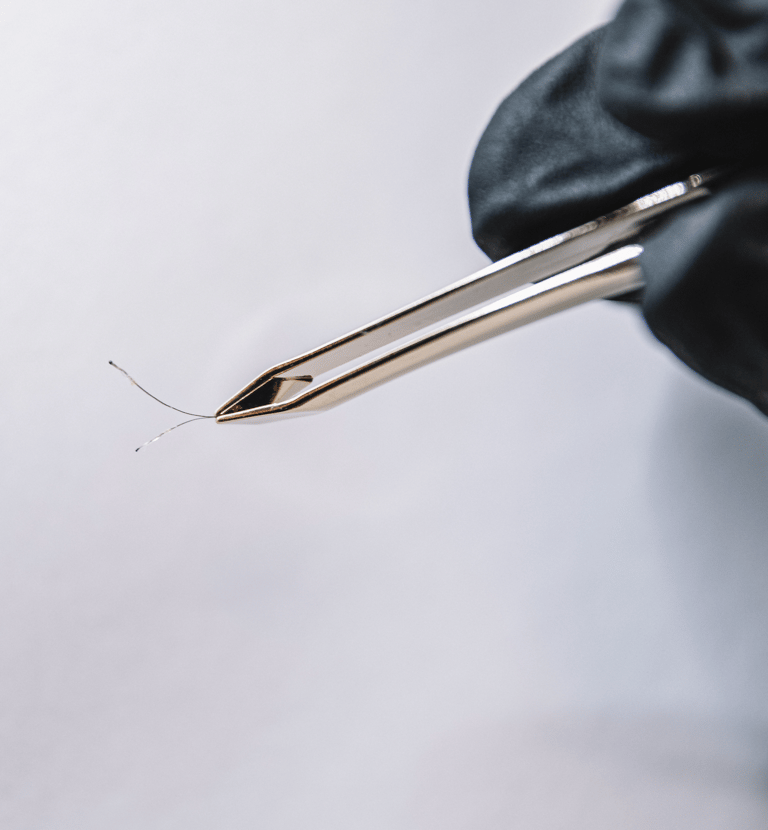
From the Stone Age to the Egyptian and Roman eras, people wanted beautiful, smooth, hairless skin. Women were constantly trying to remove unwanted hair in a variety of ways, often dangerous to their health. Various hair removal devices often consisted of shells, pumice stones, knife blades, flint razors, and even walnut oil was used to stop hair growth.
These methods of hair removal were not only dangerous to health but also ineffective.
In the 1800s, doctors began to take a greater interest in hair growth and the various methods that could stop the process. They discovered that hair grows from the bulb – the root of the hair follicle. It was discovered that when the papilla is damaged, the hair stops growing.
In 1875, Charles Michel, a physician, invented a safe method of hair removal, electroepilation, which destroys the hair permanently; his aim was to remove ingrown hairs. He wrote a scientific paper about it, which was seen by dermatologist William Hardaway, who tested this method of hair removal on his patients and later presented it to his colleagues at a meeting of the American Association of Dermatologists. There was an “explosion”, more and more medics started to talk about this innovative hair removal technology, doctors started to successfully remove hair for their patients, and thanks to Dr. William Hardaway, electroepilation became very widespread throughout the continent and later – the world.
In 1916, Paul N. Cree made electrolysis accessible to more people, as his training and marketing transformed electroepilation from a medical procedure to a cosmetic procedure.
History of electro epilation
How the procedure is performed
Electroepilation is a hair removal procedure that uses sodium hydroxide or an electrical impulse to destroy the hair bulb, resulting in the cessation of hair growth. It uses a hair-thick needle, which is usually inserted without being felt, as it is inserted close to the follicle so that the skin is not pierced. The affected hair “slides out” nicely without any resistance felt during simple plucking.






The hair follicle is destroyed by heat caused by an electrical impulse. This method of hair removal is the most common as it is quick and effective.
Types of electro epilation
Thermolysis
Galvanic
Blend
This method was the very first type of electroepilation and is rarely used these days. During this method, the follicle is exposed to a direct current of sodium hydroxide, which causes a chemical reaction that destroys the follicle. The galvanic method of hair removal takes more time therefore it is not so popular.
This is a combination of heat and a sodium hydroxide current which speeds up the galvanic chemical reaction. This method takes a little longer than thermolysis but it is very effective and is most often used in hard-to-reach areas.
All types of electro epilation are effective and, when used properly, remove hair permanently.
From which part of the body can hair be removed using the method of electro-epilation?
Hair can be removed from any part of the body using this method. It is not recommended to remove hair from the nose and ears because we need these hairs for their protective function and to keep microbes out of the body. It is best to trim it using a nose and ear hair trimmer.
Does electroepilation remove light hair?
Yes, this method can remove any color of hair from any skin color.
Is the procedure painful?
Neither yes nor no. I would be lying if I said that the procedure is not painful at all, the most appropriate description is that it is unpleasant, but the duration of the electrical impulse is very short, it takes from 1 to 3 seconds to remove a single hair, the pain is instantaneous and disappears right away. I have clients who do not feel anything at all, we work for 3–4 hours, and with more sensitive clients we simply shorten the visits to the most comfortable option, therefore, more sensitive people can have their hair removed. Applying anesthetics can be used to reduce discomfort.
Do I need maintenance procedures after the course of procedures?
No, there is no need. The only exception is if your hormonal balance changes dramatically and your body “wakes up” dormant follicles that were previously inactive and not producing hair. After a full course of electroepilation, the removed follicles cannot start growing hair.
Are there side effects?
As long as the client follows the skin care instructions after the procedure, there will be no side effects.
When can I not have the procedure?
The procedure cannot be performed if you have severe acne, hepatitis or if you are taking blood thinning medicine. If you wish to have the procedure performed on moles or during pregnancy, written consent from your doctor is required.
How long does one procedure take?
The duration of the procedure depends on the area of the removal. The maximum removal time for the facial area is 1 hour per visit. The maximum removal time for the upper lip area is 30 minutes. The average removal time for one armpit is 1–2 hours. Of course, this may vary due to individual cases. For all other areas of the body, the duration depends on the density and thickness of the hair and your wishes. As the removal takes place one hair at a time, in larger areas we work in patches.
Is the effect visible immediately?
Yes, usually after the first procedure from 10% to 40% of the hair in the area of the removal never regrows if it has been shaved or left untouched before, and the hair that does regrow tends to be thinner. After depilation or any plucking, I always tell clients to expect worsening for the first 2 months and only then – stabilization/improvement, as it can take up to 2 months for a plucked hair to regrow, so especially if we’re talking about the facial area, you should be prepared to expect the same amount of hair or even more in the first few visits than you had during your first removal. However, this is temporary, after 2 months you will see the hair getting thinner and thinner, with each visit the time between appointments will get longer and longer, and the number of hairs will reduce until they are gone for good.
How many procedures are needed to remove hair permanently?
The number of procedures depends on the removal area, the thickness of the hair, the hormonal balance, the previous removal method used, and the density of the hair. There is simply no single answer, especially without seeing the situation. The average removal time is between 8 and 24 months if the client’s visits are regular, but it is impossible to say how many procedures will be needed during this period, as it is extremely individual, so I recommend a consultation to assess the situation and to determine the length of time for the removal.
How often is the procedure recommended?
In the case of the facial area – every 1–2 weeks or as often as your skin heals quickly. The skin must be fully healed before the removal of hair in the same area. If the area is larger, for example, the legs, the removal of hair can be done every day at first, as long as the whole area is finished. Later on, as the hairs thin out, the intervals between visits also become longer. It takes 2 months for a hair removed by electroepilation to regrow (if it regrows), so any hair that regrows in the removed area during this time is new hair and not the same. If your visits are regular, then after 3–5 months you will need to visit every 4 weeks instead of 2, and later – every 5–8 weeks until you don’t need it anymore.
How do I take care of the removal area?
For more information on skin care before/after the procedure, please click on the following link:
